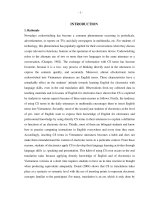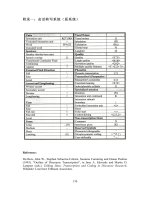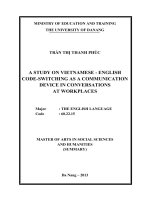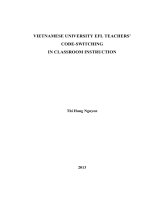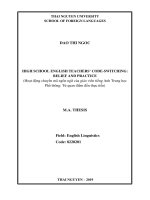HeadStart code switching
Bạn đang xem bản rút gọn của tài liệu. Xem và tải ngay bản đầy đủ của tài liệu tại đây (4.86 MB, 40 trang )
Code Switching
Why It Matters and How to Respond
A Workbook for Early Head Start/Head Start Programs
This document was prepared under Grant #90HC0001 for the U.S. Department of Health and Human
Services, Administration for Children and Families, Office of Head Start, by the National Center on
Cultural and Linguistic Responsiveness.
•• Bank Street College, , Toll free: 888.246.1975
•• Education Development Center, Inc., , Toll free: 855.494.0331
i
TABLE OF CONTENTS
Preface ..................................................................................................................................... iii
How To Use This Workbook..........................................................................................................iv
PAUSE AND REFLECT — EXERCISE 1.............................................................................................. 1
What Is Code Switching?.............................................................................................................. 2
Code Switching by Children: Does It Matter?................................................................................. 4
PAUSE AND REFLECT — EXERCISE 2.............................................................................................. 6
PAUSE AND REFLECT — EXERCISE 3.............................................................................................. 8
How Should Adults Respond When Children Code Switch?...........................................................12
Sample Adult Responses That Invite the Child to Continue the Conversation................................14
What About Teacher Code Switching?..........................................................................................19
A Common and Very Well-Intentioned Mistake...........................................................................21
Strong Language Modeling........................................................................................................ 23
PAUSE AND REFLECT — EXERCISE 4.............................................................................................24
Code Switching: What’s Next?.................................................................................................... 25
PAUSE AND REFLECT — EXERCISE 5.............................................................................................26
PAUSE AND REFLECT — EXERCISE 6.............................................................................................27
Concluding Remarks.................................................................................................................. 28
Appendix A - Sample Answers.................................................................................................... 29
Appendix B - References.............................................................................................................35
ii
PREFACE
Code switching (also
called language mixing)
occurs when a speaker
alternates between two or
more languages.
This workbook is designed to
assist Early Head Start/Head
Start and Child Care (EHS/HS/
Child Care) programs to
XX
understand code switching by
children and teachers, and
XX
identify and implement
effective program policies and
practices that promote children’s
development and school
readiness.
This document is intended for:
XX
Teaching staff to develop their knowledge about code switching and use the
exercises to refine their own skills
XX
Family service workers to share with families
XX
Leaders and trainers to provide professional development for staff
iii
HOW TO USE THIS WORKBOOK
Learning Exercises are placed throughout the workbook. Readers should
complete these short Pause and Reflect activities to
XX
enhance their understanding of code switching, and
XX
develop program-wide practices that optimally promote children’s learning.
Sample answers are provided for each exercise in Appendix A beginning
on page 29.
W H I LE CO D E S W I TCH I N G O CCU R S I N ALL L AN GUAG E S,
E X A M PLE S I N T H IS WO R K B O O K AR E PR E SEN T ED I N:
English in blue (bold underline)
Spanish in red (bold italic)
W H EN E X A M PLE S O F CO N V ER SAT I O N APPE AR I N:
Blue text (bold underline) — it is in English
Red text (bold italic) — it is in Spanish
iv
PAUSE AND REFLECT — EXERCISE 1
Getting Started: KWL Chart
This exercise allows you to PAUSE and REFLECT about what
you know about code switching before and after you begin this
workbook and after you have completed this workbook.
Directions:
Before reading this workbook, complete columns K and W.
After reading, complete column L.
K
W
L
What I already KNOW
about code switching
What I WANT to know
about code switching
What I LEARNED about
code switching
1
WHAT IS CODE SWITCHING?
Code Switching (also called language mixing) is the “use of elements from
two languages in the same utterance or in the same stretch of conversation”
(Paradis, Genesee, & Crago, 2011, p. 88).
Code switching occurs when children or adults alternate between two or
more languages.
The most common way young children mix two languages is by beginning
a sentence in one language, then switching to another (Genesee et al., 2004).
Examples of child code switching in
English and Spanish:
XX
XX
“Quiero jugar outside.”
(“I want to play outside.”)
“This is not what I want to comer.”
(“This is not what I want to eat.”)
Code switching can happen within any of the
subsystems of a language.
Spanish/English Mixing
Language Subsystem
b all - o
Ph o n o l o gi c al (s o un ds)
I t ’s r ainy - a n d o
M o r p h o l o gi c al /Sy nt a c ti c
(gr amm ar)
Quiero más juice
( I w a n t m o r e j u i c e)
S e m anti c (wo rds an d
th e ir m eanin gs)
2
WHO CODE SWITCHES?
Anyone who knows even a little bit of a second or third language
can code switch. Code switching among toddlers, children, teens,
and adults has been extensively documented across many languages
and settings.
3
CODE SWITCHING BY CHILDREN: DOES IT MATTER?
i n t h e pa s t s o m e p eo p l e t h o u g h t ...
XX children were confused and mixing their
languages in their brain (i.e., memory),
XX children could not separate the
languages,
XX code switching was a disability or
evidence of incompetence (Espinosa,
2010; Genesee et al., 2004; Hakuta,
1986), and
XX children should be punished for mixing
their languages.
NOW WE K NOW CHILDR E N AR E DO ING SOM ETH ING QUITE
R E MAR K ABLE
XX
When children code switch, they maintain
the rules of the grammar of both of their
languages (Genesee et al., 2004). Clearly
they are keeping their languages separate.
XX
Even before they are born, babies’ brains
distinguish and separate between two
languages (Byers-Heinlein et al., 2010).
4
K E Y M ESSAG ES FROM CUR R E NT R ESE ARCH
Code switching shows children’s competence
because they draw from vocabulary in all
their languages!
Current Research
XX
Code switching is typical among children
and adults who know more than one
language.
XX
Code switching is a reflection of cognitive
and communicative competence (Genesee
et al., 2004).
Adults can use instances of children’s code switching to
XX
observe their language skills, and
XX
present strong language models to support learning and
development.
Adults who listen carefully
XX
understand a child’s vocabulary, ideas, and knowledge, and then
XX
support the child to interact, extend conversations, and learn more.
It is important that Early Head Start/
Head Start and Child Care program
leaders
XX
share information about code switching
with staff, families, and community
partners, and
XX
ensure intentional and effective practices
that optimize children’s learning.
5
PAUSE AND REFLECT — EXERCISE 2
WHEN AN INFANT OR TODDLER CODE SWITCHES
DIRECTIONS: Review the examples of code switching below, and record how you would respond to extend the
conversation and build the child’s vocabulary.
SEE APPENDIX A FOR SAMPLE ANSWERS.
Meal time
Child says
More leche.
¡Rica food!
Possible adult responses
More milk.
Good food!
Child Pickup
Child says
Possible adult responses
Adiós, teacher.
Goodbye teacher.
Go casa.
Go home.
6
PAUSE AND REFLECT — EXERCISE 2
Continued
SEE APPENDIX A FOR SAMPLE ANSWERS.
Outdoor play
Child says
Tie zapato.
Possible adult responses
Tie shoe.
Espera. I tired.
Wait. I tired.
Block play
Child says
Bloques fall.
My casita.
Big torre.
Possible adult responses
Blocks fall.
My little house.
Big tower.
7
PAUSE AND REFLECT — EXERCISE 3
WHEN PRESCHOOL CHILDREN CODE SWITCH
DIRECTIONS: Review the following examples of code switching below and record how you would respond
to extend the conversation and build the child’s vocabulary.
SEE APPENDIX A FOR SAMPLE ANSWERS.
Art Area
Child says
Possible adult responses
I drew a picture of my
house y de mi gato.
I drew a picture of my
house and of my cat.
¿Do I need to wear…
esa cosa para pintar?
Do I need to wear…
that thing to paint?
Washing Hands
Child says
Possible adult responses
El agua está bien cold.
The water is very cold.
Mi mano es dirty.
My hand is dirty.
8
PAUSE AND REFLECT — EXERCISE 3
Continued
SEE APPENDIX A FOR SAMPLE ANSWERS.
Mathematics
Child says
Possible adult responses
Do you want to buy
some fruta? It costs
three dollars.
Do you want to buy
some fruit? It costs three
dollars.
A mí me gusta jugar con la
computer.
I like to play with the
computer.
Social Studies
Child says
Possible adult responses
When I grow up, quiero
ser un astronaut para ir a
la moon.
When I grow up, I want to
be an astronaut so I can
go to the moon.
My uncle is a policía.
My uncle is a police
officer.
9
PAUSE AND REFLECT — EXERCISE 3
Continued
SEE APPENDIX A FOR SAMPLE ANSWERS.
Dramatic Play
Child says
Possible adult responses
The firefighters use
ladders and hoses
cuando están trabajando.
Fire es muy peligroso.
The firefighters use
ladders and hoses when
they are working. Fire is
very dangerous.
Agarra un hat para que
juegues.
Grab a hat so you can
play.
Music
Child says
Possible adult responses
I like to cantar y bailar
every day!
I like to sing and dance
every day!
La guitar is my favorita.
The guitar is my favorite.
10
PAUSE AND REFLECT — EXERCISE 3
Continued
SEE APPENDIX A FOR SAMPLE ANSWERS.
Science Center
Child says
Possible adult responses
La planta needs water,
sun, y tierra.
The plant needs water,
sun, and dirt.
¡La ladybug se ve
grande con el glass!
The ladybug looks big
with the glass!
11
HOW SHOULD ADULTS RESPOND WHEN
CHILDREN CODE SWITCH?
When children code switch, they use all their languages to express
themselves as fully as they can. Code switching helps them develop
their communication and language skills and learn more!
CO DE SWITCHING IS COM MO N.
Therefore staff should
XX
XX
XX
expect children to code switch,
observe their language skills and
general knowledge, and
be strong language models.
CHILDR E N’S CO DE SWITCH ING IS N OT A PRO BLE M .
XX
There is no reason to “correct” children when they code switch.
XX
“Correcting” code switching ignores the competence that children demonstrate
and disregards the messages they are trying to communicate.
XX
Adults who try to “correct” children’s code switching can accidentally send the
message that children should limit their speech in order to avoid code switching.
Clearly, this is not a message that builds school readiness!
12
L ANGUAG E MO DE LING WH E N CH ILDR E N
CO DE SWITCH
Adults are strong
language models
when they:
ff
Use language to
extend children’s
original questions or
comments
ff
Listen responsively to
children
ff
Start and continue
conversations
that children are
interested in
ff
Are intentional
about supporting
vocabulary acquisition
ff
Support children in remembering and talking about past events
and personal experiences
Adults promote positive relationships and support
children’s developing language abilities when they
XX
XX
XX
accept all instances of children’s code switching as indicators of
their current communication abilities,
observe and respond to the ideas and information that children
express during code switching, and
build on children’s ideas and information by inviting them to
continue to talk about what’s important to them.
As a general rule, adults should ask questions and make
comments in only one language at a time.
13
SAMPLE ADULT
RESPONSES
THAT INVITE
THE CHILD TO
CONTINUE THE
CONVERSATION
A 2-year-old says, “More leche.”
Sample Spanish-speaking adult
responses
Sample English-speaking adult
responses
ff
“Sí, voy a darte más leche. ¿Te
gusta tomar leche?”
ff
“Here is some more milk. Do you
like to drink milk?”
ff
“¿Qué comiste con tu leche? ¿Un
plátano?”
ff
“What did you eat with your milk?
A banana?”
ff
“La leche es sana y deliciosa.
Bebemos la leche para tener
huesos y dientes fuertes.”
ff
“Milk is healthy and delicious. We
drink milk to have strong bones
and teeth.”
14
Sample adult
responses that
invite the child
to continue the
conversation
A 3-year-old in the art area says,
“I drew a picture of my house y mi gato.”
Sample Spanish-speaking adult
responses
Sample English-speaking adult
responses
ff
“Dime más sobre tu casa.”
ff
“Tell me more about your house.”
ff
“¿Cómo se llama tu gato y qué le
gusta hacer?”
ff
“What is your cat’s name, and what
does it like to do?”
ff
“¿Esto me recuerda de la semana
pasada cuando dibujaste tu casa
y tu perro. Me dijiste que tu perro
era muy juguetón y travieso.
¿Cómo es tu gato?”
ff
“This reminds me of last week
when you drew a picture of your
house and your dog. You told me
that your dog was very playful and
naughty. What is your cat like?”
15
Sample adult
responses that
invite the child
to continue the
conversation
A 4 -ye a r - o l d i n t h e o u t d o o r p l ay a r e a s ay s , “ T h e f i r e f i g h t e r s
u s e l a d d e r s a n d h o s e s c u a n d o e s t á n t ra b a j a n d o . E l f u e g o e s m u y
p e l i g r o s o .”
Sample Spanish-speaking adult
responses
Sample English-speaking adult
responses
ff
“Supongamos que ustedes son
bomberos y están en la estación
de bomberos cuando reciben una
llamada de un incendio en alguna
casa. Demuéstrenme lo que harían
primero. ¿Y después?”
ff
“Let’s pretend that you are all
firefighters and are in the fire
station when you receive a call
about a fire in a home. What would
you do first? Next?”
ff
“¿Me podrían decir cómo piensan
usar sus escaleras y mangueras?”
ff
“Would you tell me how you plan
to use your ladders and hoses?”
ff
“¿Qué debemos hacer si alguna vez
se nos enciende el cuerpo?”
ff
“What should we do if we catch on
fire?”
ff
“¿Qué debemos hacer si
escuchamos la alarma de incendios
en nuestro edificio?”
ff
“What should we do if the fire
alarm goes off in our building?”
ff
“El mes pasado aprendimos todo
acerca de los policías y un oficial
vino a visitarnos. ¿Recuerdan?
¿Qué nos dijo el oficial acerca de
los bomberos?”
ff
“Last month we learned all about
police officers, and an officer
came to visit us. Remember? What
did the police officer say about
firefighters?”
ff
Describa las acciones de los niños
como si fuese un anunciador o
comentarista deportivo: “Marco
se pone sus botas mientras Rosa
busca el extinguidor de incendios.
Mayela le ayuda a Jorge a subirse
al carro de bomberos y abren o
prenden la sirena…”
ff
Narrate the actions that the
children are doing, like a presenter
or sportscaster: “Marco is putting
on his boots, while Rosa looks for
the fire extinguisher. Mayela helps
Jorge climb onto the fire truck and
they turn on the siren…”
16
Extended Language Examples 1
Example 1: In an EHS classroom, 18-month-old Rosie is
walking back and forth between two toy shelves, visually
scanning the toys. Her language background includes
regular contact/experiences with both English and Spanish.
The teacher speaks only English.
Teacher:
I see you’re looking at the toys. [pause] Do you see anything you would
like to play with?
Rosie:
[no verbal response] Child continues to walk between the two shelves.
Teacher:
[pointing] Now you’re looking at the animals.
Rosie:
[pointing] Animales.
Teacher:
[holds out hand] Could you give me an animal?
Rosie:
[hands the teacher a toy lion]
Teacher:
Thank you! You gave me a lion. Now I have a lion with me.
Rosie:
[returns to the shelf and selects a toy tiger]
Teacher:
Look, you have a tiger. I have a lion and you have a tiger.
Rosie:
Tiger, tiger…
Teacher:
You have a tiger. I have a lion. Shall we make a zoo?
Rosie:
[nods head] Zoo. Yo fui (I went there).
Teacher:
Let’s get some blocks and make a space for your tiger and my lion.
Rosie:
[smiles and goes to the block area] Este block.
Teacher:
Thank you for the block. Let me put some together for my lion. Now you
can build for your tiger.
17
Extended Language Example 2
Example 2: In a HS classroom, 38-monthold Susana is in the dramatic play area
holding a baby doll. Her language
background includes regular contact/
experiences with both English and Spanish.
The teacher is an English-speaking
monolingual.
Susana:
This is my baby.
Teacher:
Hello, baby. What’s her name?
Susana:
She is Lupita.
Teacher:
How old is Lupita?
Susana:
She is one.
Teacher:
Lupita is one year old?
Susana:
Yes, it was her cumpleaños last week.
Teacher:
Did she have a birthday party?
Susana:
Yes, she did. She had a cake and a party. We sang. She got presents.
Teacher:
What presents did she get?
Susana:
She got clothes. Some toys. And a blanket.
Teacher:
[points to the doll] You got a blanket to cover the baby with and keep her
warm?
Susana:
Sí, la noche es muy fría.
18
WHAT ABOUT TEACHER CODE SWITCHING?
Code switching is common among
bilinguals. Code switching in adults, as in
children, represents communication.
EHS/HS/Child Care teachers and other professionals
should focus on their critical role as strong language
models whenever they are talking with children.
Teachers should engage in “teacher talk,” in which
teachers use new and novel words, extend
conversations, and expand children’s perspectives.
This kind of engagement is critical to children’s reading
success (Brophy et al., 2007; Burchinal et al., 2002;
Genesee, et al., 2004; Snow, Burns & Griffin, 1998).
It’s a balancing act!
Children in EHS/HS/Child Care
need teachers to support
their development across ALL
developmental domains.
The children need teachers who
can form close relationships with
them and nurture their growth.
A teacher who speaks their
language brings many cultural
and linguistic resources that promote children’s learning.
Teachers who speak a child’s home language may make a
deliberate decision to switch languages— sometimes for
several sentences in a row to
XX
capture or keep the children’s attention,
XX
identify key aspects of a challenging task, or
XX
help them remember information.
19
Switching languages can be particularly supportive in some situations;
however, it must be part of an intentional, balanced approach in which
teachers follow a clear plan for when they use each language and are clear
about the specific goals they seek to accomplish.
Teachers who are bilingual use their
two languages in ways that promote
children’s learning and development
when they
XX
create close and emotionally
supportive relationships with
children,
XX
provide encouragement for
children to try new things or to
persist in taking on a difficult
task,
XX
scaffold children’s learning by
drawing children’s attention to
the steps of an activity or by asking children questions that prompt
extended thinking/reasoning,
XX
connect children’s knowledge from home and community settings to
classroom experiences, and
XX
provide a preview of future activities and discuss children’s participation
in past activities.
20
